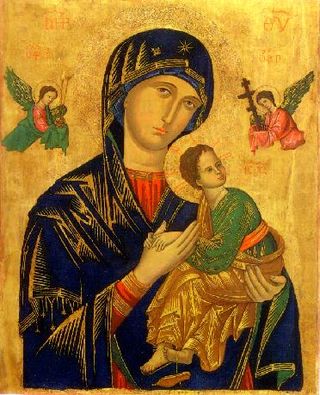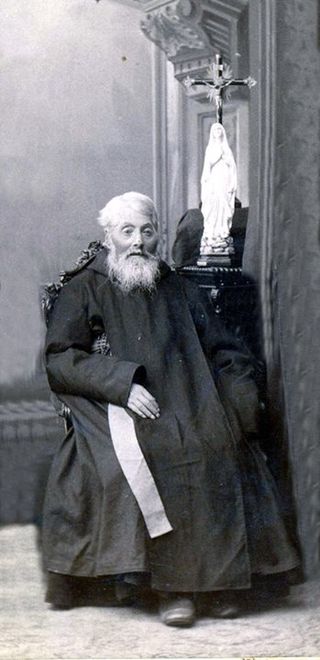
Many religious communities have the term Sisters of Charity in their name. Some Sisters of Charity communities refer to the Vincentian tradition alone, or in America to the tradition of Saint Elizabeth Ann Seton, but others are unrelated. The rule of Vincent de Paul for the Daughters of Charity has been adopted and adapted by at least sixty founders of religious institutes for sisters around the world.

The Servite Order, officially known as the Order of Servants of Mary, is one of the five original mendicant orders in the Roman Catholic Church. It includes several branches of friars, contemplative nuns, a congregation of religious sisters, and lay groups. The order's objectives are the sanctification of its members, the preaching of the Gospel, and the propagation of devotion to the Mother of God, with special reference to her sorrows. The Servites friars lead a community life in the tradition of the mendicant orders.
The Russian Greek Catholic Church or Russian Byzantine Catholic Church is a sui iuris Byzantine Rite Eastern Catholic Church of the worldwide Catholic Church. Historically, it represents both a movement away from the control of the Church by the State and towards the reunion of the Russian Orthodox Church with the Catholic Church. It is in full communion with and subject to the authority of the Pope of Rome as defined by Code of Canons of the Eastern Churches.

The Catholic Church in Georgia, since the 11th-century East–West Schism, has been composed mainly of Latin Church Catholics; a very large community of the Armenian Catholic Church has existed in Georgia since the 18th century.
A Catholic order liturgical rite is a variant of a Catholic liturgical rite distinct from the typical ones, such as the Roman Rite, but instead specific to a certain Catholic religious order.

The Congregation of Marian Fathers of the Immaculate Conception of the Most Blessed Virgin Mary is a Catholic male clerical religious congregation founded, 1670, in Poland. It is also known as Marians of the Immaculate Conception. Its members add the post-nominal letters M.I.C. after their names to indicate membership in the Congregation.

The Order of the Immaculate Conception, abbreviated OIC and also known as the Conceptionists, is a Catholic religious order of Pontifical Right for nuns founded by Saint Beatrice of Silva. For some years, they followed the Poor Clares Rule, but in 1511 they were recognized as a separate religious order, taking a new rule with the name Order of the Immaculate Conception.

A patronage of the Blessed Virgin Mary is a form of spiritual protection attributed to Mary, mother of Jesus, in favor of some occupations, activities, religious orders, congregations, dioceses, and geographic locations.

The Fivefold Scapular, also known as Redemptorist Scapular, is a sacramental made up of five best-known of the early scapulars in the Catholic Church: the Brown Scapular of the Carmelites, the Blue Scapular of the Immaculate Conception, the Black Scapular of the Servites, the Red Scapular of the Passion, and the White Scapular of the Most Holy Trinity. There are 17 total officially approved scapulars of the Catholic Church.
Georgian Byzantine Rite Catholics, or members of the Georgian Greek Catholic Church, are Catholics from the Georgian people who practice the Byzantine Rite in Old Georgian, which is also the liturgical language of the Georgian Orthodox Church.
This is a glossary of terms used within the Catholic Church. Some terms used in everyday English have a different meaning in the context of the Catholic faith, including brother, confession, confirmation, exemption, faithful, father, ordinary, religious, sister, venerable, and vow.

María del Carmen Sallés y Barangueras, also known by her religious name Carmen of Jesus, was a Spanish Roman Catholic professed religious and the founder of the Missionary Sisters of the Immaculate Conception. Sallés is best known for being a strong advocate of both genders being equal and a staunch defender of the rights of women, since she made this the focus of her life from the beginning of her entrance into religious life.
The Confraternity of the Immaculate Conception of the Blessed Virgin Mary is one of the oldest lay apostolates still operating in the Roman Catholic Church, having been part of the Congregation of Marian Fathers of the Immaculate Conception founded by Stanislaw Papczynski. "The Blessed Marian Founder fervently encouraged his spiritual sons to establish confraternities of the Immaculate Conception at Marian churches. 'The first laws of the Order of 1694-1698 speak of this already."

St. George Forane Church Kallody is situated in Mananthavady taluk of Wayanad district. It is one of the important churches and pilgrim centers in the region, in communion with the Syro-Malabar Catholic Church.
The Russian Catholic Apostolic Exarchate of Harbin is a dormant apostolic exarchate of the Russian Byzantine Catholic Church based in the city of Harbin in China. The cathedra of the apostolic exarchate was in the Cathedral of St. Vladimir in Harbin, which is now in ruins. The apostolic exarchate also had churches in Shanghai and Beijing.

Shio Batmanishvili was a Georgian Greek Catholic priest and the superior of the Servites of the Immaculate Conception. He was survivor of the Gulag at Solovki prison camp, and a martyr during Joseph Stalin's Great Purge.

Peter Kharischirashvili was a Georgian Catholic hieromonk, theologian, scientist and founder of the Servites of the Immaculate Conception.

Mary Theodore Williams, F.H.M. was an American Black Catholic nun who founded the Franciscan Handmaids of the Most Pure Heart of Mary in 1916.
















